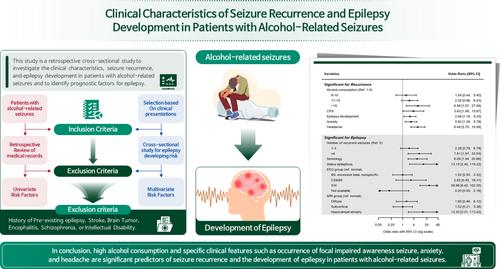Alcohol withdrawal is widely recognized as a trigger for acute symptomatic seizures among individuals with chronic alcohol consumption. While most alcohol withdrawal seizures occur shortly after cessation, chronic alcohol consumption can be associated with the development of epilepsy, necessitating anti-epileptic drug (AED) therapy. This study aimed to investigate the clinical characteristics, seizure recurrence, and epilepsy development in patients with alcohol-related seizures and to identify prognostic factors for epilepsy.
In a retrospective analysis at Ewha Womans University Mokdong Hospital, 206 patients with alcohol-related seizures were examined and 15 were excluded due to preexisting epilepsy. Demographic and clinical data, including alcohol withdrawal duration, seizure recurrence, types, and comorbidities, were investigated. Logistic regression models were used to analyze the risk factors for seizure recurrence and epilepsy development. The performance of the final models was evaluated based on the area under the receiver operating characteristic curve (AUC) and validated using calibration plots and leave-one-out cross-validation.
Of the 191 patients (146 males; mean age 48.3 ± 12.1 years) with alcohol-related seizures, 99 patients (51.8%) experienced seizure recurrence and 79 patients (41.4%) developed epilepsy. Factors associated with seizure recurrence included alcohol consumption levels, occurrence of focal impaired awareness seizure, anxiety, and headache. The number of recurrent seizures, semiology, status epilepticus, electroencephalogram findings, and brain imaging findings was associated with epilepsy development. The predictive models showed strong diagnostic performance, with AUCs of 0.833 for seizure recurrence and 0.939 for epilepsy development.
High alcohol consumption and specific clinical and diagnostic features are significant predictors of seizure recurrence and the development of epilepsy among patients with alcohol-related seizures. These findings underscore the importance of early identification and intervention to prevent seizure recurrence and the onset of epilepsy, emphasizing the importance of AED treatment in managing these conditions.


